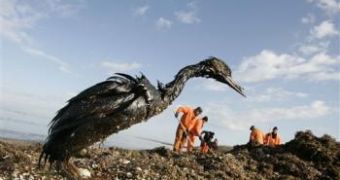The oil spill wipes out life on its way; the tidal areas are depleted of life. A large array of sea species, from marine mammals (cetaceans, seals, otters) to sea birds, turtles, fish, crustaceans, and mollusks lose their habitat. The petroleum attacks directly the animals and plants, both physically and chemically. Most animals die smeared by the oil or intoxicated by hydrocarbons. Clams and cockles have no chance.
The fuel breaks down the natural oils of the sea birds' plumage, secreted by the uropygial gland (near the base of the tail). The birds are now missing isolation from the freezing waters and floatability on water. If these birds don't drown, they die of hypothermia. The drowned ones are eaten by fishes and other birds and the contamination spreads. The most vulnerable birds to oil spills are those most bound to the sea, like guillemots, razorbills, puffins, shags, gannets and loons (during the winter).
Sea mammals, like seals, can get lung intoxication from the petroleum. Cetaceans, like dolphins, porpoises and false killer whales can get their breathing duct, mouth and genitalia tapped by oil, which can also enter their stomachs.
Bottom animals, like mussels, which feed by filtering the water, ingest very quickly the toxins and die, but they can store toxins from the water for long periods of time. Crabs eat the intoxicated corpses, storing toxins too. The most affected fish species are the bottom ones, like rays, congers, soles, and flounders.
Dune ecosystems are severely hit. The effect of the oil spills is significant in the shore areas that are breeding and refuge areas for many marine species. Oil mixed with sand can cover sea beds down to 30 m (100 ft) in depth, killing sea cucumbers, scallops, starfishes, sponges, sea snails, octopuses, cuttlefish, squids, spider crabs and velvet crabs.
Marine flora cannot make photosynthesis, the light being dim, and the oxygen is scarce. The ecosystems require 6 to 10 years to recover. Recovered birds with oiled plumage are wrapped in cloths to avoid hypothermia and kept in dark cages to avoid stress. A soft detergent can cleanse their plumage and they are forced to eat. But many of the thousands of cleansed birds released in their environment die in about 10 days. Why? Besides the shock suffered because of humans handling them, the birds swallow oil while trying to clean their plumage.
That's why they must be fed with a mix of kaolin, charcoal and glucose, this way trying to eliminate the oil toxins. Even so, many birds cannot further reproduce and the action of cleansing them is just cosmetic. Marine mammal with oiled fur must go through the same stages.

 14 DAY TRIAL //
14 DAY TRIAL //